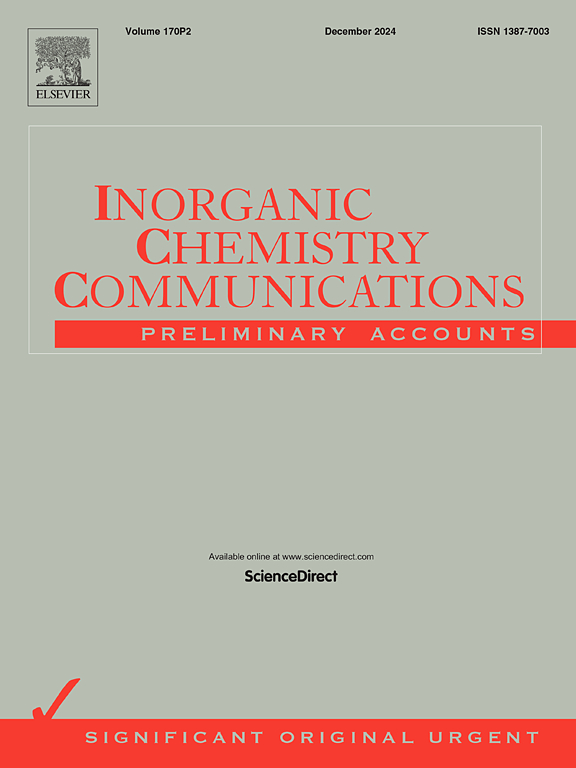Electrochemical performance of ZnCo2O4@Mn-Ni(OH)2 core-shell composites for high-efficiency supercapacitors
IF 4.4
3区 化学
Q1 CHEMISTRY, INORGANIC & NUCLEAR
引用次数: 0
Abstract
Enhancing the capacitance of supercapacitors represents a critical direction in the advancement of energy storage technologies. Therefore, a novel core–shell structure (ZnCo2O4@Mn-Ni(OH)2) with ZnCo2O4 nanosheets as the core scaffold and Mn-doped Ni(OH)2 nanosheets as the active shells was successfully synthesized. Notably, the bimetallic ZnCo2O4 nanosheets acted as the core to accelerate electron transfer, improve the mechanical stability of the electrodes, and provide abundant attaching points for shell growth. Specifically, the successful integration of Mn atoms into Ni(OH)2 resulted in two significant outcomes: an increase in redox sites to enhance capacitance, and a concomitant acceleration in electron and ion migration rates to improve reaction kinetics. In consequence, the ZnCo2O4@Mn-Ni(OH)2 composite material exhibited excellent capacitance (12.66 F cm−2 at 2 mA cm−2) and capacity maintenance of 85.6 % following 4000 cycles. The ZnCo2O4@Mn-Ni(OH)2//AC hybrid supercapacitors (HSC) device assembled with an activated carbon (AC) electrode achieved 0.38 mWh cm−2 at 3.00 mW cm−2. In particular, after 4000 cycles, the HSC device still had 94.4 % capacity retention. Two HSC devices in a serially connected could power a red light-emitting diode (LED) for a duration of over 80 min. These findings provide a new strategy for improving electrochemical performance and show great potential for practical applications.

ZnCo2O4@Mn-Ni(OH)2核壳复合材料高效超级电容器的电化学性能
提高超级电容器的电容是储能技术发展的一个重要方向。因此,以ZnCo2O4纳米片为核心支架,mn掺杂Ni(OH)2纳米片为活性壳层,成功合成了新型核壳结构(ZnCo2O4@Mn-Ni(OH)2)。值得注意的是,双金属ZnCo2O4纳米片作为核心加速了电子转移,提高了电极的机械稳定性,并为壳的生长提供了丰富的附着点。具体来说,Mn原子成功整合到Ni(OH)2中导致了两个显著的结果:氧化还原位点的增加以增强电容,以及伴随的电子和离子迁移速率的加速以改善反应动力学。结果表明,ZnCo2O4@Mn-Ni(OH)2复合材料在2 mA cm−2时具有12.66 F cm−2的优良电容,在4000次循环后容量维持率为85.6%。用活性炭(AC)电极组装的ZnCo2O4@Mn-Ni(OH)2//AC混合超级电容器(HSC)装置在3.00 mW cm - 2下可获得0.38 mWh cm - 2。特别是,经过4000次循环后,HSC设备仍有94.4%的容量保留率。两个HSC器件串联在一起,可以为红色发光二极管(LED)供电超过80分钟。这些发现为提高电化学性能提供了新的策略,并显示出巨大的实际应用潜力。
本文章由计算机程序翻译,如有差异,请以英文原文为准。
求助全文
约1分钟内获得全文
求助全文
来源期刊

Inorganic Chemistry Communications
化学-无机化学与核化学
CiteScore
5.50
自引率
7.90%
发文量
1013
审稿时长
53 days
期刊介绍:
Launched in January 1998, Inorganic Chemistry Communications is an international journal dedicated to the rapid publication of short communications in the major areas of inorganic, organometallic and supramolecular chemistry. Topics include synthetic and reaction chemistry, kinetics and mechanisms of reactions, bioinorganic chemistry, photochemistry and the use of metal and organometallic compounds in stoichiometric and catalytic synthesis or organic compounds.
 求助内容:
求助内容: 应助结果提醒方式:
应助结果提醒方式:


